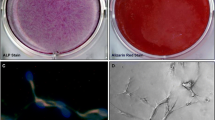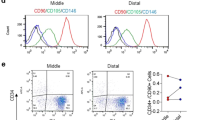Abstract
Purpose
The anterior cruciate ligament (ACL) rarely heals spontaneously after rupture. Mesenchymal stem cells (MSCs) contribute to healing in various tissues, therefore, they may also have a key role in healing after ACL rupture. The purpose of this study was to investigate the properties of MSCs in ruptured ACLs.
Methods
Human ACL samples were harvested from patients undergoing primary ACL reconstruction, and samples were classified by the number of days post rupture (phase I <21 days; phase II 21–56 days; phase III 57–139 days phase IV ≥140 days). We evaluated the characteristics of MSCs, such as colony-forming capacity, differentiation potential and cell-surface markers.
Results
There was a tendency for high colony-forming capacity during phases I and II, which tended to decrease in phase III. Chondrogenic, adipogenic and osteogenic differentiation potential was maintained until phase II but decreased in phase III. Most surface-epitope expression was consistent from phase I to III: positive for CD44, CD73, CD90 and CD105; negative for CD11b, CD19, CD34, CD45 and human leukocyte antigen-D-related (HLA-DR). The presence of these surface markers proved the existence of MSCs in ruptured ACL tissue.
Conclusions
Our results suggest that colony-forming and differentiation potential decrease over time. It is important to consider changes in properties of MSCs and use ACL tissue in the acute phase of rupture when biological manipulation is required.





Similar content being viewed by others
References
Butler DL, Noyes FR, Grood ES (1980) Ligamentous restraints to anterior-posterior drawer in the human knee. A biomechanical study. J Bone Joint Surg Am 62(2):259–270
Murray MM, Spindler KP (2005) Anteiror cruciate ligament healing and repair. Sports Med Arthrosc Rev 13(3):151–155
Woo SL, Vogrin TM, Abramowitch SD (2000) Healing and repair of ligament injuries in the knee. J Am Acad Orthop Surg 8(6):364–372
Murray MM, Martin SD, Martin TL, Spector M (2000) Histological changes in the human anterior cruciate ligament after rupture. J Bone Joint Surg Am 82(10):1387–1397
Lo IK, Marchuk L, Hart DA, Frank CB (2003) Messenger ribonucleic acid levels in disrupted human anterior cruciate ligaments. Clin Orthop Relat Res 407:249–258
Bramono DS, Richmond JC, Weitzel PP, Chernoff H, Martin I, Volloch V, Jakuba CM, Diaz F, Gandhi JS, Kaplan DL, Altman GH (2005) Characterization of transcript levels for matrix molecules and proteases in ruptured human anterior cruciate ligaments. Connect Tissue Res 46(1):53–65
Beye JA, Hart DA, Bray RC, McDougall JJ, Salo PT (2008) Injury-induced changes in mRNA levels differ widely between anterior cruciate ligament and medial collateral ligament. Am J Sports Med 36(7):1337–1346
AbiEzzi SS, Foulk RA, Harwood FL, Akeson WH, Amiel D (1997) Decrease in fibronectin occurs coincident with the increased expression of its integrin receptor α5β1 in stress-deprived ligaments. Iowa Orthop J 17:102–109
Cameron M, Buchgraber A, Passler H, Vogt M, Thonar E, Fu F, Evans CH (1997) The natural history of the anterior cruciate ligament-deficient knee. Changes in synovial fluid cytokine and keratan sulfate concentrations. Am J Sports Med 25(6):751–754
Higuchi H, Shirakura K, Kimura M, Terauchi M, Shinozaki T, Watanabe H, Takagishi K (2006) Changes in biochemical parameters after anterior cruciate ligament injury. Int Orthop 30(1):43–47
Ivkovic A, Marijanovic I, Hudetz D, Porter RM, Pecina M, Evans CH (2011) Regenerative medicine and tissue engineering in orthopaedic surgery. Front Biosci (Elite Ed) 3:923–944
Gao J, Caplan AI (2003) Mesenchymal stem cells and tissue engineering for orthopaedic surgery. Chir Organi Mov 88(3):305–316
Zhi L, Chen C, Pang X, Uludag H, Jiang H (2011) Synergistic effect of recombinant human bone morphogenic protein-7 and osteogenic differentiation medium on human bone-marrow-derived mesenchymal stem cells in vitro. Int Orthop 35(12):1889–1895
Rui YF, Lui PP, Lee YW, Chan KM (2011) Higher BMP receptor expression and BMP-2-induced osteogenic differentiation in tendon-derived stem cells compared with bone-marrow-derived mesenchymal stem cells. Int Orthop. doi:10.1007/s00264-011-1417-1
Ben-Ami E, Berrih-Aknin S, Miller A (2011) Mesenchymal stem cells as an immunomodulatory therapeutic strategy for autoimmune diseases. Autoimmun Rev 10(7):410–415
Wu L, Leijten JC, Georgi N, Post JN, van Blitterswijk CA, Karperien M (2011) Trophic effects of mesenchymal stem cells increase chondrocyte proliferation and matrix formation. Tissue Eng Part A 17(9–10):1425–1436
Prockop DJ (1997) Marrow stromal cells as stem cells for nonhematopoietic tissues. Science 276(5309):71–74
Zuk PA, Zhu M, Ashjian P, De Ugarte DA, Huang JI, Mizuno H, Alfonso ZC, Fraser JK, Benhaim P, Hedrick MH (2002) Human adipose tissue is a source of multipotent stem cells. Mol Biol Cell 13(12):4279–4295
De Bari C, Dell’Accio F, Tylzanowski P, Luyten FP (2001) Multipotent mesenchymal stem cells from adult human synovial membrane. Arthritis Rheum 44(8):1928–1942
Cheng MT, Yang HW, Chen TH, Lee OK (2009) Isolation and characterization of multipotent stem cells from human cruciate ligaments. Cell Prolif 42(4):448–460
Segawa Y, Muneta T, Makino H, Nimura A, Mochizuki T, Ju YJ, Ezura Y, Umezawa A, Sekiya I (2009) Mesenchymal stem cells derived from synovium, meniscus, anterior cruciate ligament, and articular chondrocytes share similar gene expression profiles. J Orthop Res 27(4):435–441
Sakaguchi Y, Sekiya I, Yagishita K, Muneta T (2005) Comparison of human stem cells derived from various mesenchymal tissues. Arthritis Rheum 52(8):2521–2529
Schmitt B, Ringe J, Häupl T, Notter M, Manz R, Burmester GR, Sittinger M, Kaps C (2003) BMP2 initiates chondrogenic lineage development of adult human mesenchymal stem cells in high-density culture. Differentiation 71(9–10):567–577
Sekiya I, Larson BL, Vuoristo JT, Reger RL, Prockop DJ (2005) Comparison of effect of BMP-2, -4, and -6 on in vitro cartilage formation of human adult stem cells from bone marrow stroma. Cell Tissue Res 320(2):269–276
Steinert AF, Kunz M, Prager P, Barthel T, Jakob F, Nöth U, Murray MM, Evans CH, Porter RM (2011) Mesenchymal stem cell characteristics of human anterior cruciate ligament outgrowth cells. Tissue Eng Part A 17(9–10):1375–1388
Kawabata H, Katsura T, Kondo E, Kitamura N, Miyatake S, Tanabe Y, Setoguchi T, Komiya S, Yasuda K (2009) Stress deprivation from the patellar tendon induces apoptosis of fibroblasts in vivo with activation of mitogen-activated protein kinases. J Biomech 42(15):2611–2615
Lacey DC, Simmons PJ, Graves SE, Hamilton JA (2009) Proinflammatory cytokines inhibit osteogenic differentiation from stem cells: implications for bone repair during inflammation. Osteoarthr Cartil 17(6):735–742
Mountziaris PM, Tzouanas SN, Mikos AG (2010) Dose effect of tumor necrosis factor-alpha on in vitro osteogenic differentiation of mesenchymal stem cells on biodegradable polymeric microfiber scaffolds. Biomaterials 31(7):1666–1675
Matsumoto T, Ingham SM, Mifune Y, Osawa A, Logar A, Usas A, Kuroda R, Kurosaka M, Fu FH, Huard J (2011) Isolation and characterization of human anterior cruciate ligament-derived vascular stem cells. Stem Cells Dev. doi:10.1089/scd.2010.0528
Shibata KR, Aoyama T, Shima Y, Fukiage K, Otsuka S, Furu M, Kohno Y, Ito K, Fujibayashi S, Neo M, Nakayama T, Nakamura T, Toguchida J (2007) Expression of the p16INK4A gene is associated closely with senescence of human mesenchymal stem cells and is potentially silenced by DNA methylation during in vitro expansion. Stem Cells 25(9):2371–2382
Dexheimer V, Mueller S, Braatz F, Richter W (2011) Reduced reactivation from dormancy but maintained lineage choice of human mesenchymal stem cells with donor age. PLoS One. doi:10.1371/journal.pone.0022980
Morito T, Muneta T, Hara K, Ju YJ, Mochizuki T, Makino H, Umezawa A, Sekiya I (2008) Synovial fluid-derived mesenchymal stem cells increase after intra-articular ligament injury in humans. Rheumatology (Oxford) 47(8):1137–1143
Conflict of interest
The authors declare that they have no conflict of interest.
Author information
Authors and Affiliations
Corresponding author
Rights and permissions
About this article
Cite this article
Nohmi, S., Yamamoto, Y., Mizukami, H. et al. Post injury changes in the properties of mesenchymal stem cells derived from human anterior cruciate ligaments. International Orthopaedics (SICOT) 36, 1515–1522 (2012). https://doi.org/10.1007/s00264-012-1484-y
Received:
Accepted:
Published:
Issue Date:
DOI: https://doi.org/10.1007/s00264-012-1484-y




